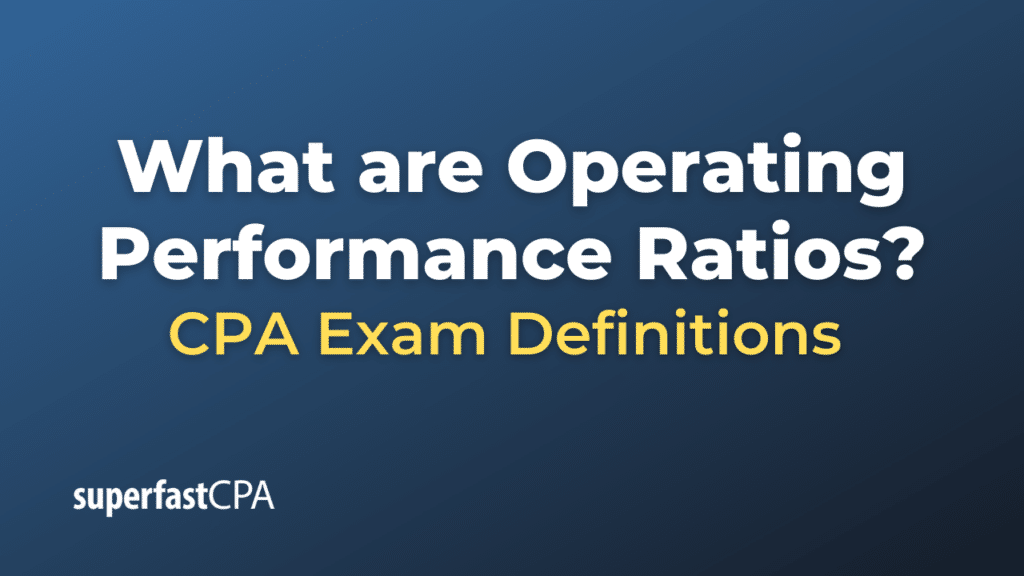Operating Performance Ratios
Operating performance ratios are a group of financial metrics used to evaluate a company’s efficiency and effectiveness in its core operations. These ratios can provide insights into how well a company uses its resources to generate sales, profit, and cash flow. They can also help to identify trends and make comparisons with other companies in the same industry.
Here are some key operating performance ratios:
- Gross Profit Margin: This ratio measures the percentage of revenue that exceeds the cost of goods sold (COGS). It’s calculated by subtracting COGS from revenue and dividing the result by revenue. A higher gross profit margin indicates that a company is more efficient at turning raw materials into income.
- Operating Profit Margin: This ratio measures how much profit a company makes from its core operations, before deducting interest and taxes. It’s calculated by dividing operating income by total revenue. A higher operating margin indicates that the company is more efficient at converting sales into actual profit.
- Net Profit Margin: This ratio measures how much of each dollar of revenue a company keeps as profit after all expenses, taxes, and costs are deducted. It’s calculated by dividing net profit by total revenue. A higher net profit margin means the company is more effective at converting revenue into actual profit.
- Return on Assets (ROA): This ratio measures how efficiently a company uses its assets to generate profits. It’s calculated by dividing net income by total assets. A higher ROA indicates that a company is better at using its assets to generate income.
- Return on Equity (ROE): This ratio measures how effectively a company uses the money invested by its shareholders to generate profits. It’s calculated by dividing net income by shareholder’s equity. A higher ROE indicates a more efficient use of investors‘ capital.
- Asset Turnover Ratio: This ratio measures how efficiently a company uses its assets to generate sales. It’s calculated by dividing total revenue by total assets. A higher asset turnover ratio means the company is more efficient at using its assets to generate sales.
Remember, when interpreting these ratios, it’s essential to consider the company’s industry, as what’s considered a good ratio can vary significantly from one industry to another. It’s also useful to look at trends in these ratios over time or to compare them with those of the company’s competitors.
Example of Operating Performance Ratios
Let’s take the hypothetical company, Example Corp., and calculate some operating performance ratios. Here are some simplified numbers for the fiscal year:
- Revenue: $1,000,000
- Cost of Goods Sold (COGS): $400,000
- Operating Expenses: $200,000
- Net Income: $300,000
- Total Assets: $2,000,000
- Shareholder’s Equity: $1,500,000
Now, let’s calculate the ratios:
- Gross Profit Margin:
Gross Profit = Revenue – COGS = $1,000,000 – $400,000 = $600,000
Gross Profit Margin = (Gross Profit / Revenue) * 100% = ($600,000 / $1,000,000) * 100% = 60% - Operating Profit Margin:
Operating Income = Gross Profit – Operating Expenses = $600,000 – $200,000 = $400,000
Operating Profit Margin = (Operating Income / Revenue) * 100% = ($400,000 / $1,000,000) * 100% = 40% - Net Profit Margin:
Net Profit Margin = (Net Income / Revenue) * 100% = ($300,000 / $1,000,000) * 100% = 30% - Return on Assets (ROA):
ROA = (Net Income / Total Assets) * 100% = ($300,000 / $2,000,000) * 100% = 15% - Return on Equity (ROE):
ROE = (Net Income / Shareholder’s Equity) * 100% = ($300,000 / $1,500,000) * 100% = 20% - Asset Turnover Ratio:
Asset Turnover Ratio = Revenue / Total Assets = $1,000,000 / $2,000,000 = 0.5 times
These ratios give us insights into the company’s operational efficiency and profitability. For instance, Example Corp. is retaining 30% of each dollar of revenue as profit (after all expenses and taxes), and it is generating 15% return on its assets and 20% return on equity.
However, keep in mind that these ratios need to be compared with industry standards or with ratios of other companies in the same industry to gain meaningful insights. The standalone figures don’t provide much information without a benchmark or trend analysis.













